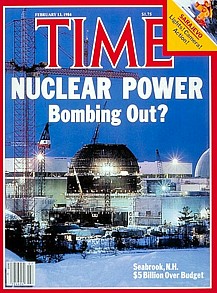Why were only 12% of the projected 1000 nuclear plants built in the U.S. by
the year 2000?
Because of the no nukes movement started in Seabrook, New Hampshire
in 1977.
And because New Hampshire banned CWIP.
Here in Georgia in 2012 we can cut to the chase and do what they
did that worked.
Harvey Wasserman wrote for The Free Press 13 May 2007,
How creative mass non-violence beat a nuke and launched the global green power movement,
Thirty years ago this month, in the small seacoast town of Seabrook,
New Hampshire, a force of mass non-violent green advocacy collided
 with the nuke establishment.
with the nuke establishment.
A definitive victory over corporate power was won. And the global
grassroots “No Nukes” movement emerged as one of the most important
and effective in human history.
It still writes the bottom line on atomic energy and global warming.
All today’s green energy battles can be dated to May, 13, 1977, when
550 Clamshell Alliance protestors walked victoriously free after
thirteen days of media-saturated imprisonment. Not a single US
reactor ordered since that day has been completed.
How effective?
Richard Nixon had pledged to build 1000 nukes in the US by the year
2000. But the industry peaked at less than 120. Today, just over a
hundred operate. No US reactor ordered since 1974 has been
completed. The Seabrook demonstrations—which extended to
civil disobedience actions on Wall Street—were key to keeping
nearly 880 US reactors unbuilt.
The only new nukes ordered since then are the ones Georgia Power
wants to build at Plant Vogtle on the Savannah River, for which
Georgia Power customers are already getting billed Construction
Work in Progress (CWIP).
Thirty years later, some things haven’t changed:
Continue reading →
Savannah, Ga.— The Coastal Group Sierra Club is sponsoring a presentation by Dr. Sydney Smith, owner of a solar farm in Bulloch County and co-founder of Lower Rates for Customers, which is currently providing solar power to a business in Savannah and looking to expand, selling its solar power below Georgia Power’s rates.
Although Georgia’s solar potential is enormous, Georgia is one of four states that does not allow energy to be purchased from private suppliers. Learn how Smith is challenging the law and Georgia Power to pave the way for lower rates and green energy.
The presentation begins at 7 p.m., Thursday, April 19 at the First Presbyterian Church, 520 Washington Ave., in Savannah.



